Comprehensive Analysis of the Human Digestive System & Nutrition
VerifiedAdded on 2023/06/11
|10
|1619
|415
Presentation
AI Summary
This presentation provides a comprehensive overview of the human digestive system, detailing its functions in breaking down food into essential nutrients for energy, growth, and repair. It explores the roles of various organs, including the mouth, pharynx, oesophagus, stomach, small intestine, large intestine, and accessory organs like the liver, gallbladder, and pancreas, in the digestive process. The presentation outlines the different stages of digestion—ingestion, digestion, absorption, and excretion—explaining how the body processes food from initial intake to the elimination of waste. It also describes the structure and function of the excretory system, including the liver, large intestine, lungs, and kidneys, in removing waste from the body. Furthermore, the presentation elucidates how the circulatory system works in conjunction with the digestive system to transport nutrients in and out of the body, ensuring that all cells receive the necessary nourishment. The presentation concludes by emphasizing the importance of the digestive system in maintaining overall health and well-being.
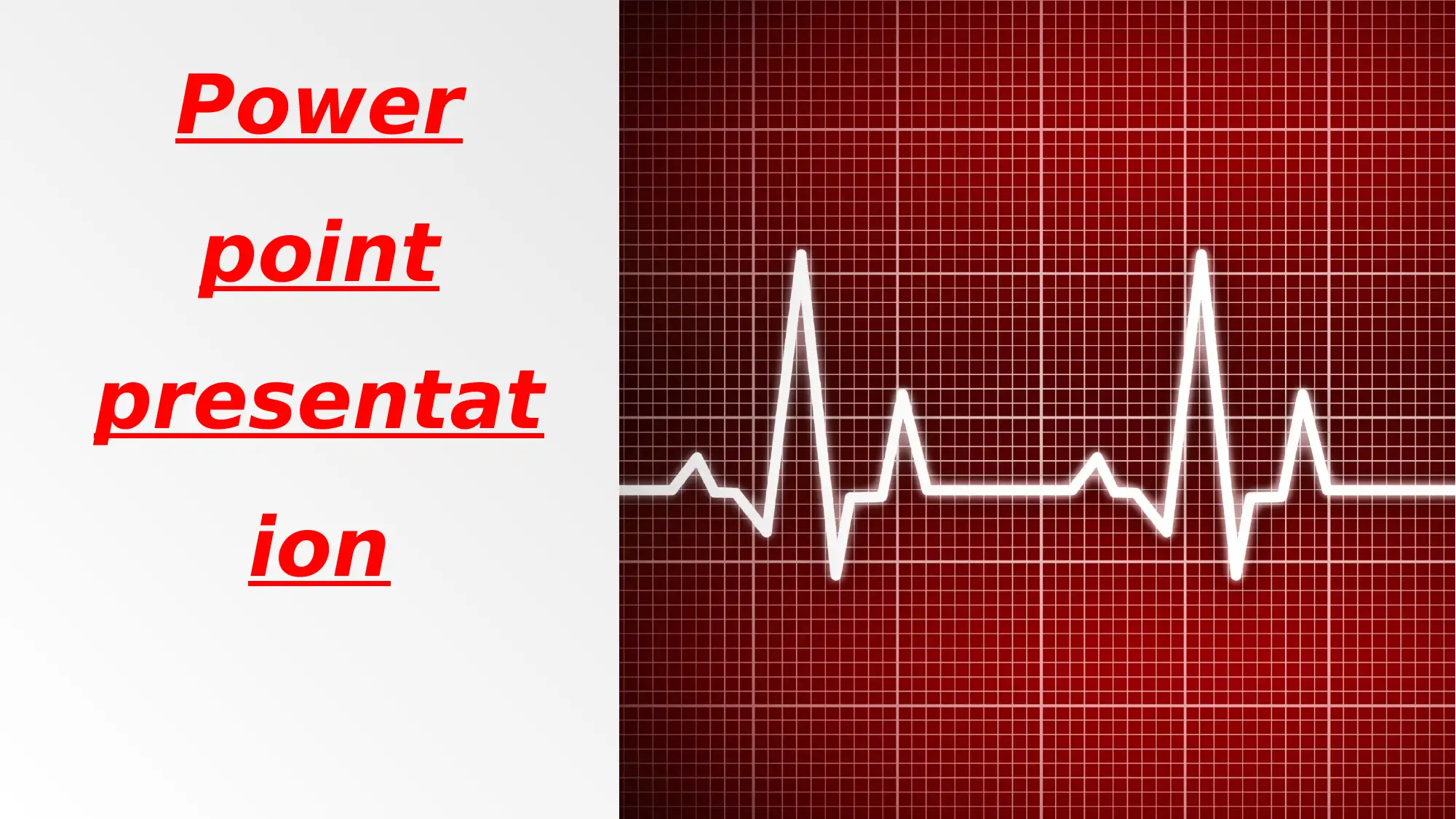
Power
point
presentat
ion
point
presentat
ion
Paraphrase This Document
Need a fresh take? Get an instant paraphrase of this document with our AI Paraphraser
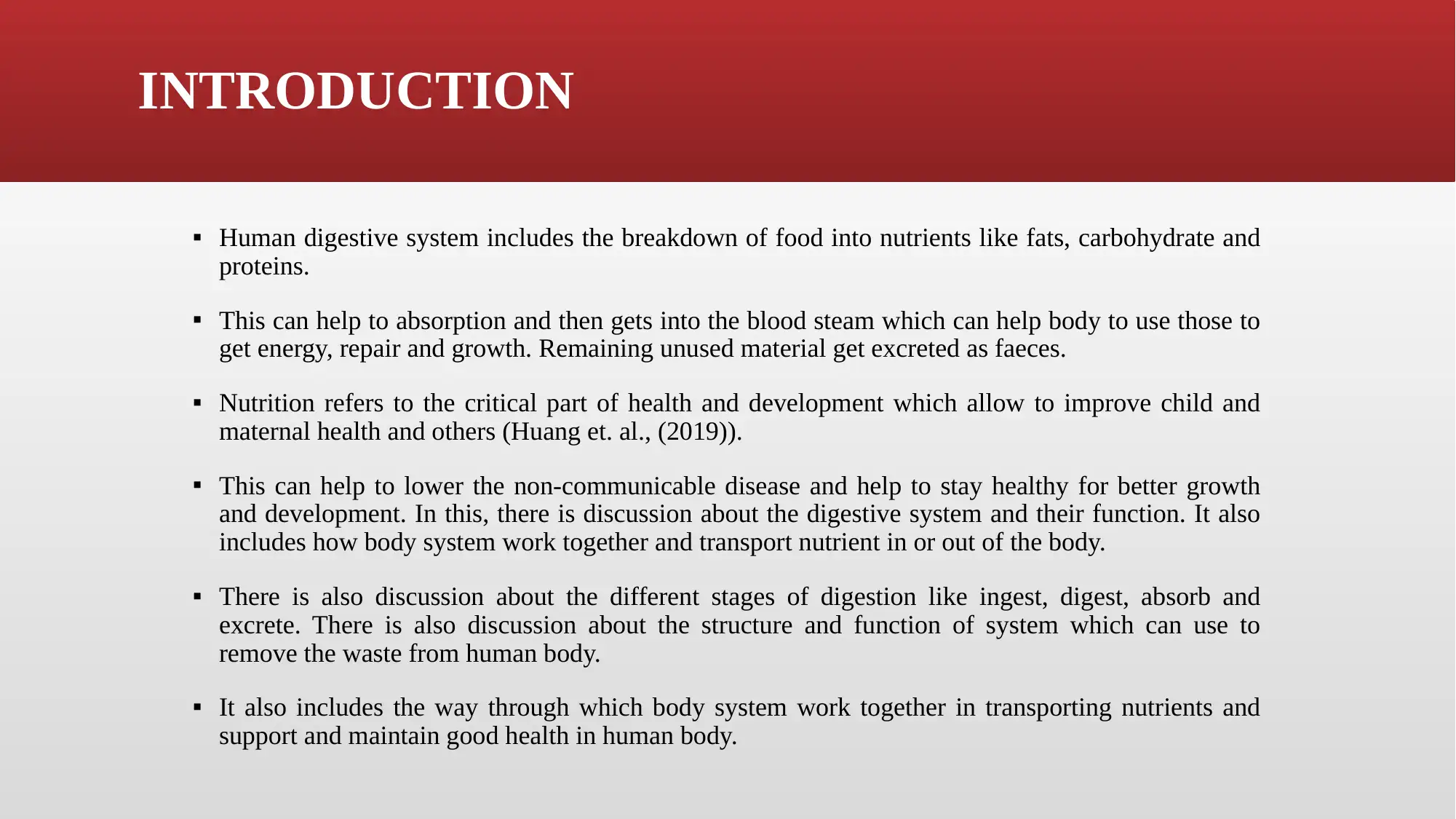
INTRODUCTION
▪ Human digestive system includes the breakdown of food into nutrients like fats, carbohydrate and
proteins.
▪ This can help to absorption and then gets into the blood steam which can help body to use those to
get energy, repair and growth. Remaining unused material get excreted as faeces.
▪ Nutrition refers to the critical part of health and development which allow to improve child and
maternal health and others (Huang et. al., (2019)).
▪ This can help to lower the non-communicable disease and help to stay healthy for better growth
and development. In this, there is discussion about the digestive system and their function. It also
includes how body system work together and transport nutrient in or out of the body.
▪ There is also discussion about the different stages of digestion like ingest, digest, absorb and
excrete. There is also discussion about the structure and function of system which can use to
remove the waste from human body.
▪ It also includes the way through which body system work together in transporting nutrients and
support and maintain good health in human body.
▪ Human digestive system includes the breakdown of food into nutrients like fats, carbohydrate and
proteins.
▪ This can help to absorption and then gets into the blood steam which can help body to use those to
get energy, repair and growth. Remaining unused material get excreted as faeces.
▪ Nutrition refers to the critical part of health and development which allow to improve child and
maternal health and others (Huang et. al., (2019)).
▪ This can help to lower the non-communicable disease and help to stay healthy for better growth
and development. In this, there is discussion about the digestive system and their function. It also
includes how body system work together and transport nutrient in or out of the body.
▪ There is also discussion about the different stages of digestion like ingest, digest, absorb and
excrete. There is also discussion about the structure and function of system which can use to
remove the waste from human body.
▪ It also includes the way through which body system work together in transporting nutrients and
support and maintain good health in human body.
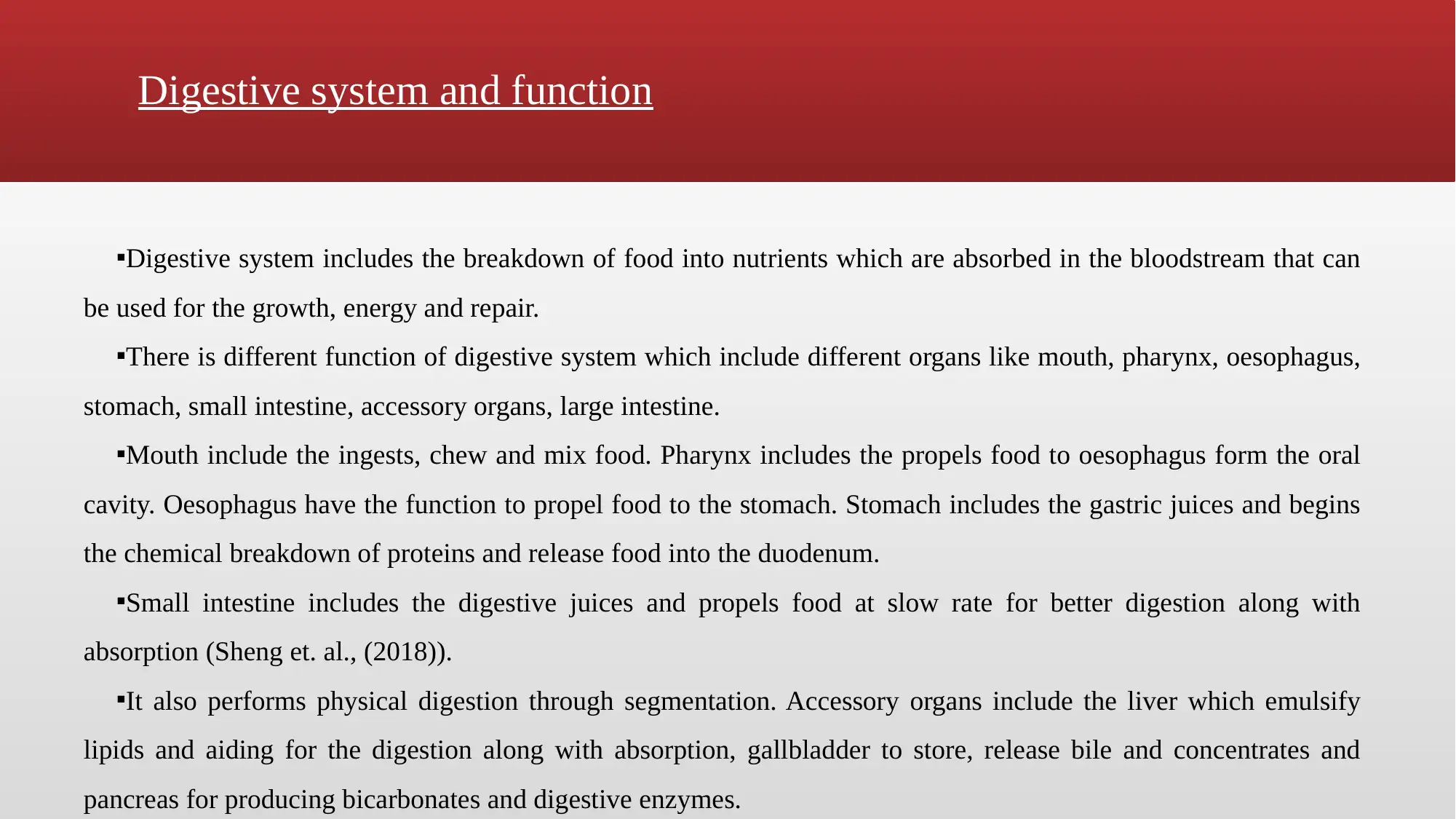
Digestive system and function
▪Digestive system includes the breakdown of food into nutrients which are absorbed in the bloodstream that can
be used for the growth, energy and repair.
▪There is different function of digestive system which include different organs like mouth, pharynx, oesophagus,
stomach, small intestine, accessory organs, large intestine.
▪Mouth include the ingests, chew and mix food. Pharynx includes the propels food to oesophagus form the oral
cavity. Oesophagus have the function to propel food to the stomach. Stomach includes the gastric juices and begins
the chemical breakdown of proteins and release food into the duodenum.
▪Small intestine includes the digestive juices and propels food at slow rate for better digestion along with
absorption (Sheng et. al., (2018)).
▪It also performs physical digestion through segmentation. Accessory organs include the liver which emulsify
lipids and aiding for the digestion along with absorption, gallbladder to store, release bile and concentrates and
pancreas for producing bicarbonates and digestive enzymes.
▪Digestive system includes the breakdown of food into nutrients which are absorbed in the bloodstream that can
be used for the growth, energy and repair.
▪There is different function of digestive system which include different organs like mouth, pharynx, oesophagus,
stomach, small intestine, accessory organs, large intestine.
▪Mouth include the ingests, chew and mix food. Pharynx includes the propels food to oesophagus form the oral
cavity. Oesophagus have the function to propel food to the stomach. Stomach includes the gastric juices and begins
the chemical breakdown of proteins and release food into the duodenum.
▪Small intestine includes the digestive juices and propels food at slow rate for better digestion along with
absorption (Sheng et. al., (2018)).
▪It also performs physical digestion through segmentation. Accessory organs include the liver which emulsify
lipids and aiding for the digestion along with absorption, gallbladder to store, release bile and concentrates and
pancreas for producing bicarbonates and digestive enzymes.
⊘ This is a preview!⊘
Do you want full access?
Subscribe today to unlock all pages.

Trusted by 1+ million students worldwide
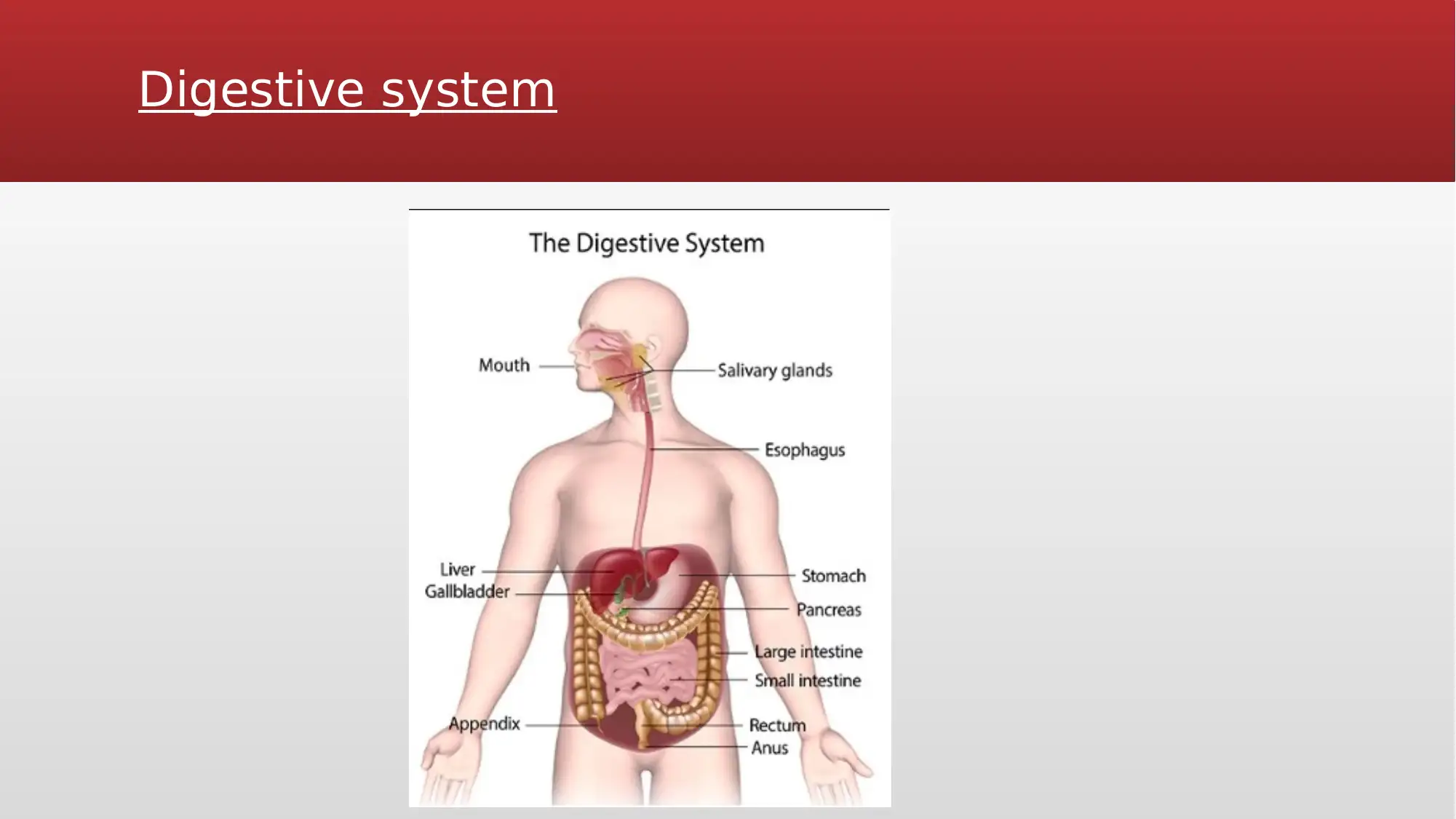
Digestive system
Paraphrase This Document
Need a fresh take? Get an instant paraphrase of this document with our AI Paraphraser

What happens when human eat food
▪ Food is start from moving through Gastrointestinal tract and that is swallow through pushing
tongue into the throat.
▪ Then oesophagus push it and lead to take the food to the stomach. Here, Stomach muscles
mixed the food with the digestive juice and empty its content and put it into the small intestine
(Li et. al., (2020)).
▪ After that, small intestine take the mixed food with digestive juice through the pancreas,
intestine and liver and push the mixture to further digestion.
▪ After that small intestine walls are able to observe digested nutrients and water into the blood
stream and waste product get to the large intestine.
▪ Now, large intestine collect the waste product from the digestive process and observe water
and take the undigested food or waste from liquid into stool and move it into rectum.
▪ These are the process which are included when any individual eat food.
▪ Food is start from moving through Gastrointestinal tract and that is swallow through pushing
tongue into the throat.
▪ Then oesophagus push it and lead to take the food to the stomach. Here, Stomach muscles
mixed the food with the digestive juice and empty its content and put it into the small intestine
(Li et. al., (2020)).
▪ After that, small intestine take the mixed food with digestive juice through the pancreas,
intestine and liver and push the mixture to further digestion.
▪ After that small intestine walls are able to observe digested nutrients and water into the blood
stream and waste product get to the large intestine.
▪ Now, large intestine collect the waste product from the digestive process and observe water
and take the undigested food or waste from liquid into stool and move it into rectum.
▪ These are the process which are included when any individual eat food.

Different stages of digestion (ingest, digest, absorb, excrete)
▪There are different stages of digestion which is an effective and can help individual to a stay healthy without
getting changes in their process. Here, process includes ingestion, digestion, absorption and excretion.
▪Ingestion refers to the first step of digestion in which food has been taken into the oral cavity and includes the
process of taken it or swallow it for the further digestion process.
▪Digest is the process in which individual muscle push food from upper part of the body to lower part into the
stomach where real action begins through using of digestive juices and enzymes. This is able to break down the food
which has been swallowed and chewed (Slorach et. al., (2019)).
▪Absorption include the movement of nutrients, electrolytes and water from lumin of the small intestine into
the body cells. It can include absorption of protein, lipids and carbohydrate from the food.
▪After the absorption process excretion process begins where undigested and waste get eliminated from the
individual body as a waste or harmful matter.
▪There are different stages of digestion which is an effective and can help individual to a stay healthy without
getting changes in their process. Here, process includes ingestion, digestion, absorption and excretion.
▪Ingestion refers to the first step of digestion in which food has been taken into the oral cavity and includes the
process of taken it or swallow it for the further digestion process.
▪Digest is the process in which individual muscle push food from upper part of the body to lower part into the
stomach where real action begins through using of digestive juices and enzymes. This is able to break down the food
which has been swallowed and chewed (Slorach et. al., (2019)).
▪Absorption include the movement of nutrients, electrolytes and water from lumin of the small intestine into
the body cells. It can include absorption of protein, lipids and carbohydrate from the food.
▪After the absorption process excretion process begins where undigested and waste get eliminated from the
individual body as a waste or harmful matter.
⊘ This is a preview!⊘
Do you want full access?
Subscribe today to unlock all pages.

Trusted by 1+ million students worldwide
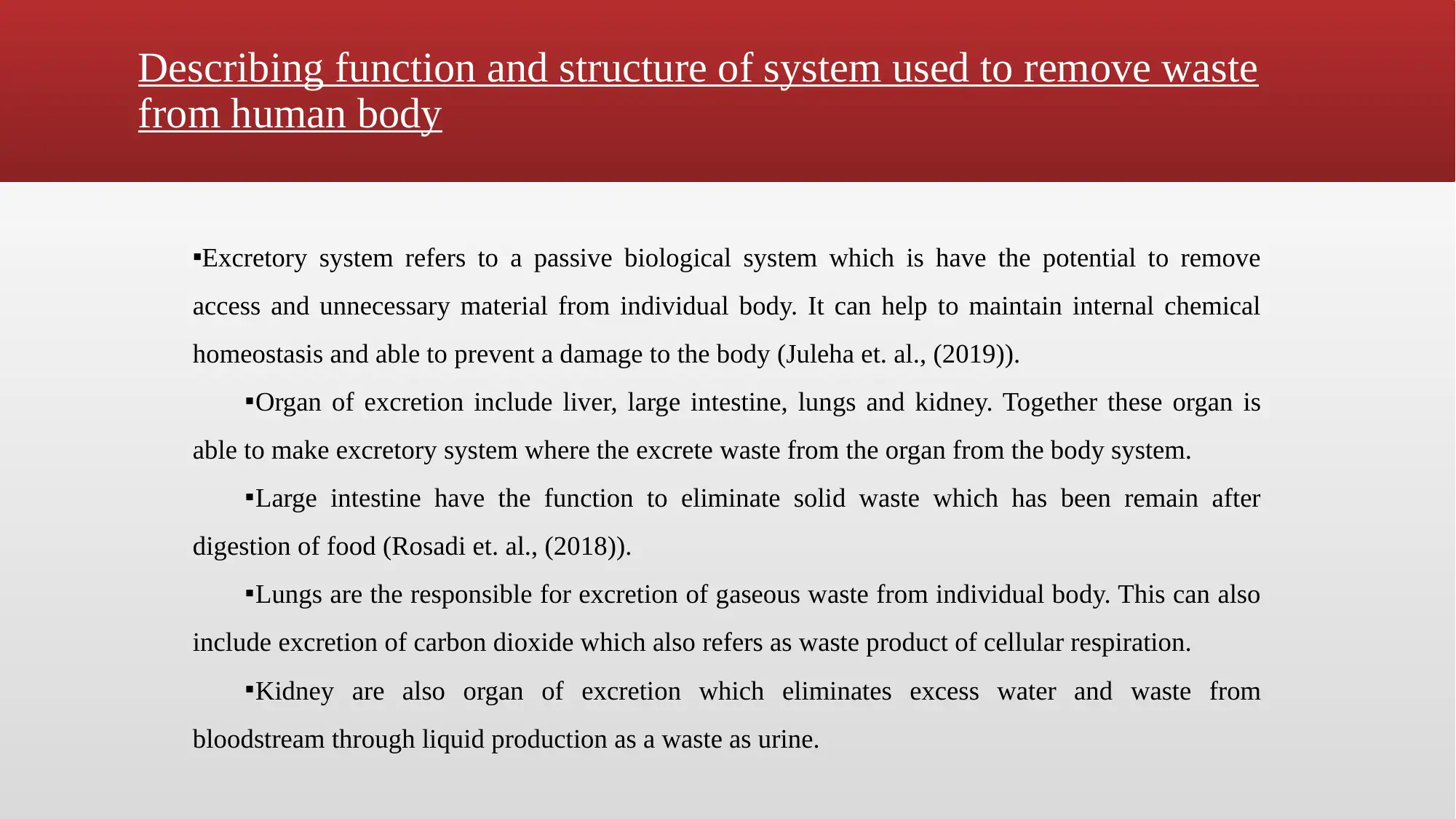
Describing function and structure of system used to remove waste
from human body
▪Excretory system refers to a passive biological system which is have the potential to remove
access and unnecessary material from individual body. It can help to maintain internal chemical
homeostasis and able to prevent a damage to the body (Juleha et. al., (2019)).
▪Organ of excretion include liver, large intestine, lungs and kidney. Together these organ is
able to make excretory system where the excrete waste from the organ from the body system.
▪Large intestine have the function to eliminate solid waste which has been remain after
digestion of food (Rosadi et. al., (2018)).
▪Lungs are the responsible for excretion of gaseous waste from individual body. This can also
include excretion of carbon dioxide which also refers as waste product of cellular respiration.
▪Kidney are also organ of excretion which eliminates excess water and waste from
bloodstream through liquid production as a waste as urine.
from human body
▪Excretory system refers to a passive biological system which is have the potential to remove
access and unnecessary material from individual body. It can help to maintain internal chemical
homeostasis and able to prevent a damage to the body (Juleha et. al., (2019)).
▪Organ of excretion include liver, large intestine, lungs and kidney. Together these organ is
able to make excretory system where the excrete waste from the organ from the body system.
▪Large intestine have the function to eliminate solid waste which has been remain after
digestion of food (Rosadi et. al., (2018)).
▪Lungs are the responsible for excretion of gaseous waste from individual body. This can also
include excretion of carbon dioxide which also refers as waste product of cellular respiration.
▪Kidney are also organ of excretion which eliminates excess water and waste from
bloodstream through liquid production as a waste as urine.
Paraphrase This Document
Need a fresh take? Get an instant paraphrase of this document with our AI Paraphraser
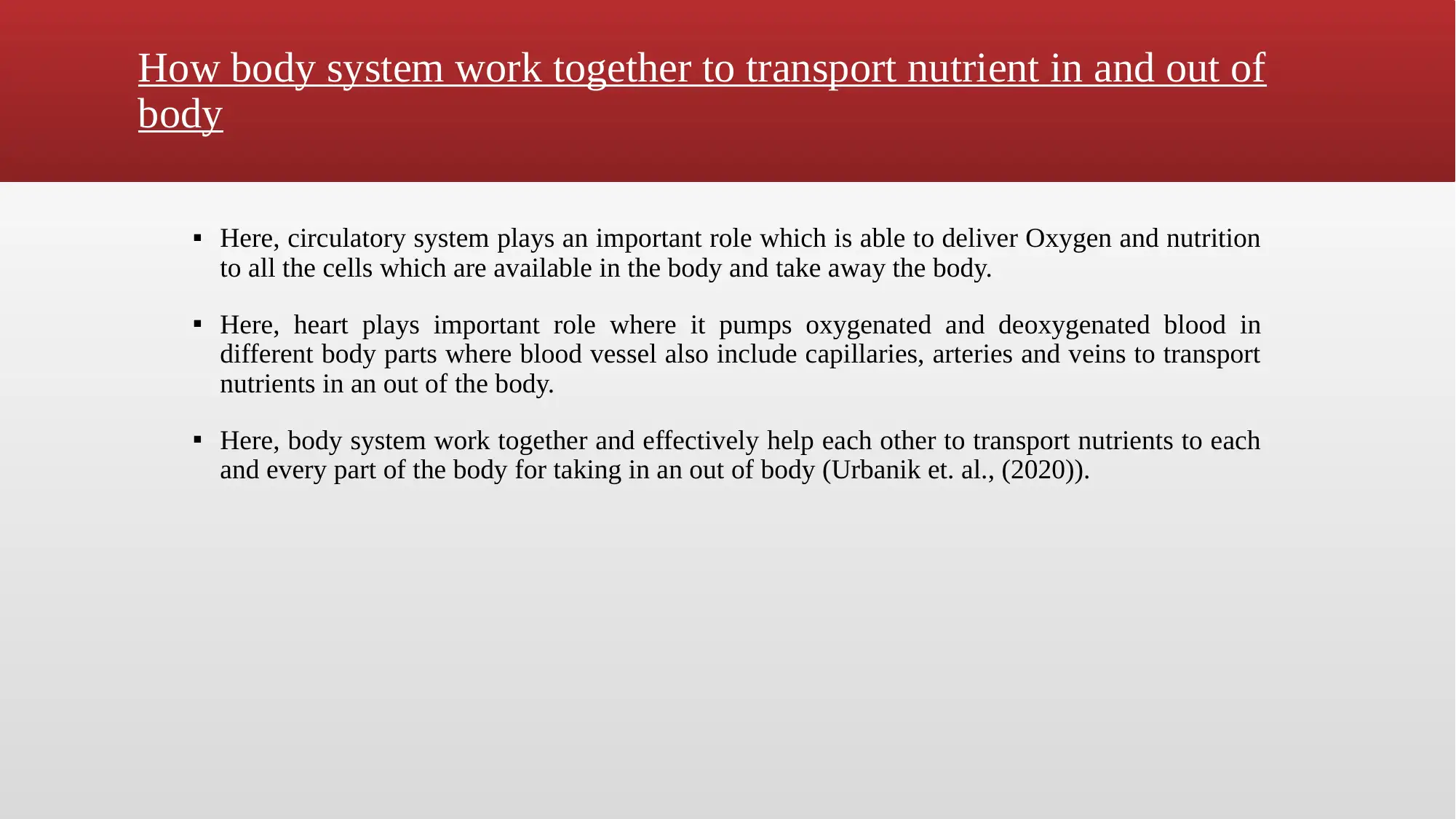
How body system work together to transport nutrient in and out of
body
▪ Here, circulatory system plays an important role which is able to deliver Oxygen and nutrition
to all the cells which are available in the body and take away the body.
▪ Here, heart plays important role where it pumps oxygenated and deoxygenated blood in
different body parts where blood vessel also include capillaries, arteries and veins to transport
nutrients in an out of the body.
▪ Here, body system work together and effectively help each other to transport nutrients to each
and every part of the body for taking in an out of body (Urbanik et. al., (2020)).
body
▪ Here, circulatory system plays an important role which is able to deliver Oxygen and nutrition
to all the cells which are available in the body and take away the body.
▪ Here, heart plays important role where it pumps oxygenated and deoxygenated blood in
different body parts where blood vessel also include capillaries, arteries and veins to transport
nutrients in an out of the body.
▪ Here, body system work together and effectively help each other to transport nutrients to each
and every part of the body for taking in an out of body (Urbanik et. al., (2020)).
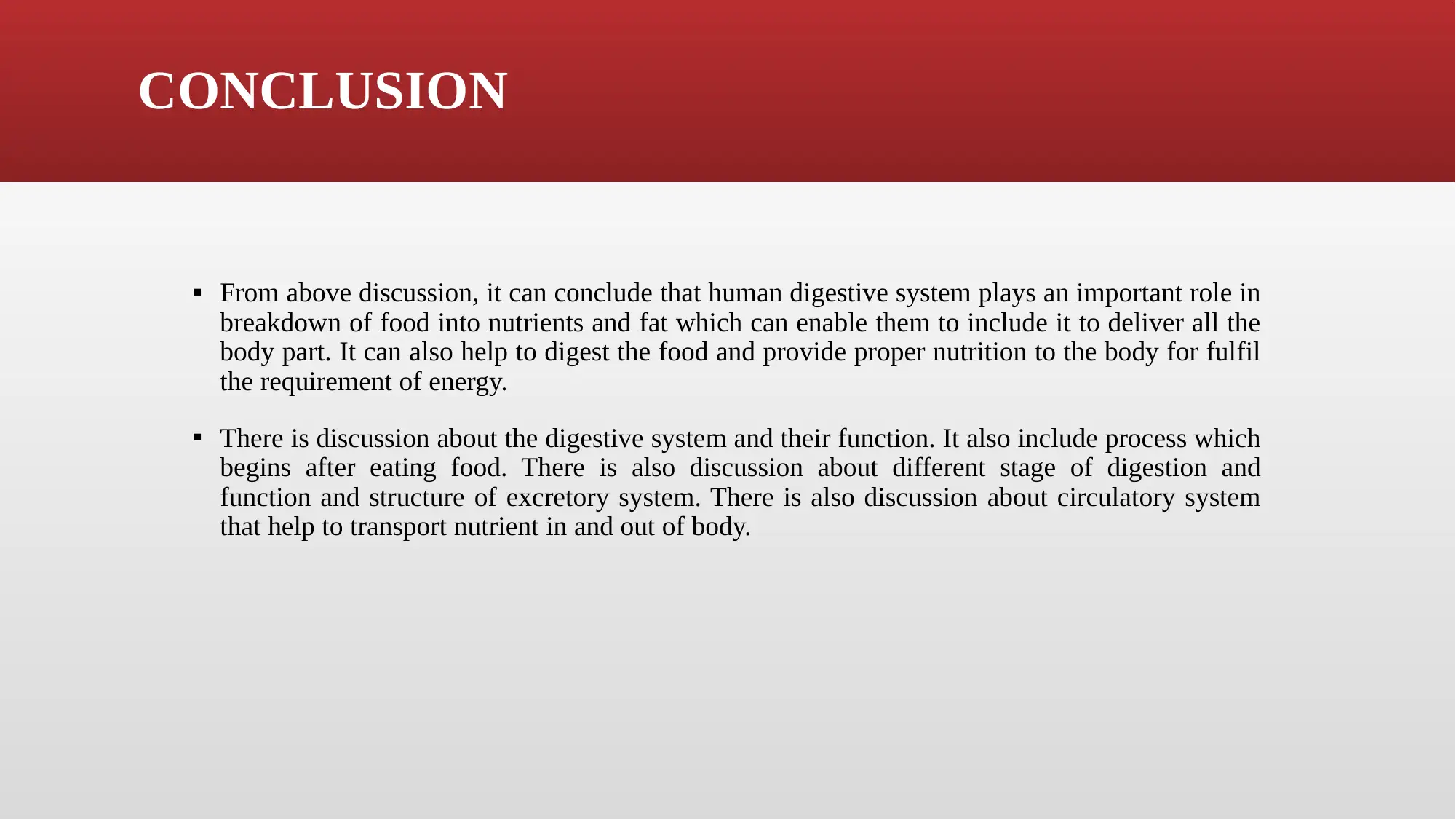
CONCLUSION
▪ From above discussion, it can conclude that human digestive system plays an important role in
breakdown of food into nutrients and fat which can enable them to include it to deliver all the
body part. It can also help to digest the food and provide proper nutrition to the body for fulfil
the requirement of energy.
▪ There is discussion about the digestive system and their function. It also include process which
begins after eating food. There is also discussion about different stage of digestion and
function and structure of excretory system. There is also discussion about circulatory system
that help to transport nutrient in and out of body.
▪ From above discussion, it can conclude that human digestive system plays an important role in
breakdown of food into nutrients and fat which can enable them to include it to deliver all the
body part. It can also help to digest the food and provide proper nutrition to the body for fulfil
the requirement of energy.
▪ There is discussion about the digestive system and their function. It also include process which
begins after eating food. There is also discussion about different stage of digestion and
function and structure of excretory system. There is also discussion about circulatory system
that help to transport nutrient in and out of body.
⊘ This is a preview!⊘
Do you want full access?
Subscribe today to unlock all pages.

Trusted by 1+ million students worldwide
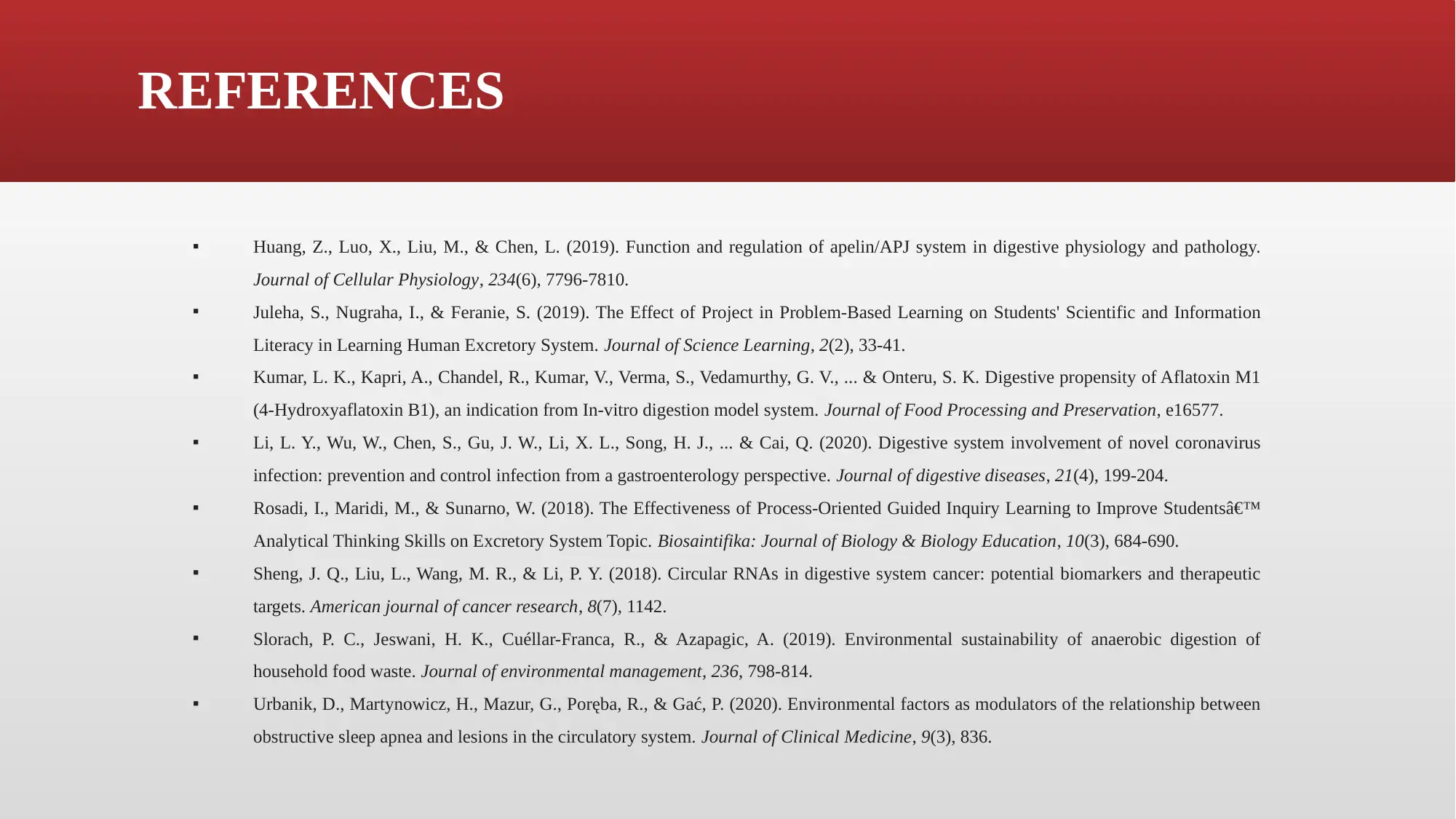
REFERENCES
▪ Huang, Z., Luo, X., Liu, M., & Chen, L. (2019). Function and regulation of apelin/APJ system in digestive physiology and pathology.
Journal of Cellular Physiology, 234(6), 7796-7810.
▪ Juleha, S., Nugraha, I., & Feranie, S. (2019). The Effect of Project in Problem-Based Learning on Students' Scientific and Information
Literacy in Learning Human Excretory System. Journal of Science Learning, 2(2), 33-41.
▪ Kumar, L. K., Kapri, A., Chandel, R., Kumar, V., Verma, S., Vedamurthy, G. V., ... & Onteru, S. K. Digestive propensity of Aflatoxin M1
(4‐Hydroxyaflatoxin B1), an indication from In‐vitro digestion model system. Journal of Food Processing and Preservation, e16577.
▪ Li, L. Y., Wu, W., Chen, S., Gu, J. W., Li, X. L., Song, H. J., ... & Cai, Q. (2020). Digestive system involvement of novel coronavirus
infection: prevention and control infection from a gastroenterology perspective. Journal of digestive diseases, 21(4), 199-204.
▪ Rosadi, I., Maridi, M., & Sunarno, W. (2018). The Effectiveness of Process-Oriented Guided Inquiry Learning to Improve Students’
Analytical Thinking Skills on Excretory System Topic. Biosaintifika: Journal of Biology & Biology Education, 10(3), 684-690.
▪ Sheng, J. Q., Liu, L., Wang, M. R., & Li, P. Y. (2018). Circular RNAs in digestive system cancer: potential biomarkers and therapeutic
targets. American journal of cancer research, 8(7), 1142.
▪ Slorach, P. C., Jeswani, H. K., Cuéllar-Franca, R., & Azapagic, A. (2019). Environmental sustainability of anaerobic digestion of
household food waste. Journal of environmental management, 236, 798-814.
▪ Urbanik, D., Martynowicz, H., Mazur, G., Poręba, R., & Gać, P. (2020). Environmental factors as modulators of the relationship between
obstructive sleep apnea and lesions in the circulatory system. Journal of Clinical Medicine, 9(3), 836.
▪ Huang, Z., Luo, X., Liu, M., & Chen, L. (2019). Function and regulation of apelin/APJ system in digestive physiology and pathology.
Journal of Cellular Physiology, 234(6), 7796-7810.
▪ Juleha, S., Nugraha, I., & Feranie, S. (2019). The Effect of Project in Problem-Based Learning on Students' Scientific and Information
Literacy in Learning Human Excretory System. Journal of Science Learning, 2(2), 33-41.
▪ Kumar, L. K., Kapri, A., Chandel, R., Kumar, V., Verma, S., Vedamurthy, G. V., ... & Onteru, S. K. Digestive propensity of Aflatoxin M1
(4‐Hydroxyaflatoxin B1), an indication from In‐vitro digestion model system. Journal of Food Processing and Preservation, e16577.
▪ Li, L. Y., Wu, W., Chen, S., Gu, J. W., Li, X. L., Song, H. J., ... & Cai, Q. (2020). Digestive system involvement of novel coronavirus
infection: prevention and control infection from a gastroenterology perspective. Journal of digestive diseases, 21(4), 199-204.
▪ Rosadi, I., Maridi, M., & Sunarno, W. (2018). The Effectiveness of Process-Oriented Guided Inquiry Learning to Improve Students’
Analytical Thinking Skills on Excretory System Topic. Biosaintifika: Journal of Biology & Biology Education, 10(3), 684-690.
▪ Sheng, J. Q., Liu, L., Wang, M. R., & Li, P. Y. (2018). Circular RNAs in digestive system cancer: potential biomarkers and therapeutic
targets. American journal of cancer research, 8(7), 1142.
▪ Slorach, P. C., Jeswani, H. K., Cuéllar-Franca, R., & Azapagic, A. (2019). Environmental sustainability of anaerobic digestion of
household food waste. Journal of environmental management, 236, 798-814.
▪ Urbanik, D., Martynowicz, H., Mazur, G., Poręba, R., & Gać, P. (2020). Environmental factors as modulators of the relationship between
obstructive sleep apnea and lesions in the circulatory system. Journal of Clinical Medicine, 9(3), 836.
1 out of 10
Related Documents
Your All-in-One AI-Powered Toolkit for Academic Success.
+13062052269
info@desklib.com
Available 24*7 on WhatsApp / Email
![[object Object]](/_next/static/media/star-bottom.7253800d.svg)
Unlock your academic potential
Copyright © 2020–2025 A2Z Services. All Rights Reserved. Developed and managed by ZUCOL.




